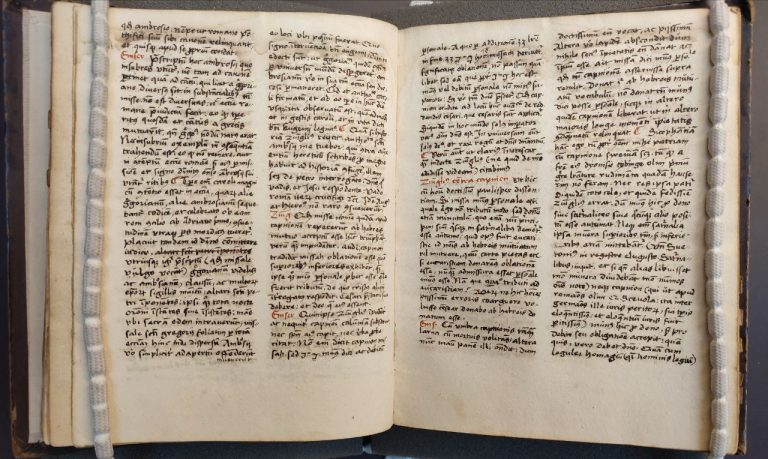Rahel Micklich (postdoctoral research fellow, Julius Maximilian University of Würzburg) about the unearthing of an unknown manuscript of Hieronymus Emser’s ‘Canonis Missae contra Huldricum Zvinglium Defensio’ in celebration of the latter’s quincentenary.
The Bodleian Library, famous for its treasures and rich history, never fails to surprise. This holds true even for Colin Harris, the former Superintendent of the Bodleian’s Special Collections Reading Rooms, who devoted five decades of his life to this role and can still be found sitting at the very end of the Mackerras Reading Room on level one of the Weston Library, every Monday to Friday! It was here that he, while poring over prints, rare books, and photographs, ‘stumbled’ upon an uncatalogued manuscript, which is preceded by a brief introduction that runs:
Judocus Clithopheus in propugnaculo suo, lib. i, cap. 6 sic ait: Superioribus diebus insigni eruditione praeclarus, et Christiane pietatis contra impios hostes generosus assertor, Hieronimus Emserus elaboravit egregiam sacri canonis defensionem contra Huldricum Zwinglium, Luterane factionis improbum militem. Cuius obtrectationes insanias in eandem misse partem omnium sacratissimam et oblatrationes impias, acerrime retundit. Idem quoque Luteri missandi formulam succincte, et praeclare confutat, particulatim singulis Luteri dictis responsiones proprias accomoda[n]s, verbis quidem breves, sed secundas sententiis et varietate rerum scitu dignissimarum respersas. Hec ille.
„Josse van Clichtove says thus in his Propugnaculum, book 1, chapter 6: In previous days, Hieronymus Emser, distinguished by his remarkable erudition and noble-minded advocate of the Christian faith against its impious enemies, accomplished an excellent defence of the sacred canon contra Huldrych Zwingli, the Lutherans’ wicked soldier. He forcefully repels his acts of defamation, frenzies targeting the very part of the Mass which is most holy to all, but also his godless ranting and raving. Likewise, he succinctly and superbly refutes Luther‘s formula for celebrating the Mass, particularly by offering his own answers to each of Luther’s arguments, which, to be sure, do not use many words, yet are beneficially interwoven with thoughts and a variety of matters highly worth knowing. That’s what he wrote.“

The inconspicuous text of our manuscript is nestled in the middle of a 16th-century collective volume, primarily composed of anti-Lutheran polemics and tracts defending the Catholic Mass. This year now marks the quincentenary of its source text.

The volume can be found under the shelfmark 4° N 14(5) Th BS, bound in a 19th century Bodleian binding and fittingly titled Eckius Aliique Contra Lutheranos („Eckius and others against the Lutherans“). It is composed of two parts, the first one consisting of two texts authored by one of Martin Luther’s staunchest opponents, the Catholic scholastic and theologian Johann Eck (1486–1543). The Bodleian purchased it in the 17th century. Its second and larger part counts ten texts, acquired by the Bodleian in 1835 from the famous auction house Sotheby’s, which was selling portions of the library of the German physician and book collector Georg Kloss (1787–1854). In this second part, writings by Johann Eck or Berno von Reichenau (c. 978–1048), Hieronymus Emser (1477–1527), Johann Cochlaeus (1479–1552) and Friedrich Nausea (c. 1496–1552) can be found.
Among those publications, Colin spotted the manuscript. Hidden in the volume, it hasn’t attracted any particular attention so far, if at all. The handwritten copy contains Hieronymus Emser’s Canonis Missae contra Huldricum Zvinglium Defensio (Dresden, 1524), published in defence of the canon of the Mass against the Swiss Reformer Huldrych Zwingli. Emser composed it right after his Missae Christianorum Contra Luteranam missandi formulam Assertio (Dresden, also 1524), a sharp argument against Martin Luther’s reform project of the traditional Mass, an issue passionately disputed at the time.
Luther wrote several tracts discussing the right form of the Mass, among others his Sermon von dem neuen Testament, das ist von der heyligen Messe, published in 1520, a „buͤchlin von der heiligen Messe“ („a smallish book about the Holy Mass“), as Emser scornfully puts it. It alone sufficed, so Emser, to call Luther „des Entchrists Vorläufer“ („the Antichrist’s predecessor“). In 1523, Luther published his Formula Missae et Communionis pro Ecclesia Vuittembergensi, long-awaited by (and dedicated to) Nikolaus Hausmann, a pastor in Zwickau who had repeatedly asked for advice regarding the reorganisation of the liturgy. It was this text that brought Hieronymus Emser to the scene, who replied with a defence of the Mass, the aforementioned Missae Christianorum contra Lutheranam missandi formulam Assertio, published on February 29th in 1524 and dedicated to the very same Nikolaus Hausmann. Emser thought it to be absurd to ask Luther – of all the people – for advice, an excommunicated outcast who wasn’t even permitted to attend Mass. According to him, it was foolish, like Judas, to seek advice from Caiaphas (cf. Mt. 26: 14–16) who is unable to grant it (sig. Aijv: Quis tamen adeo mente desipiat, ut cum Iuda a Caipha consilium petat: quod is nec illi praestare queat?).
Emser targeted yet another critic in the matter: Huldrych Zwingli. In 1523, Zwingli too pushed for a reform of the Mass and its liturgy, primarily criticising its sacrificial and priestly nature. The canon be nothing else but a loose compilation of little prayers (sig. bijr: nihil aliud quam precularum quarundam), put together after Ambrose or Gregory the Great. The Swiss Reformer’s De Canone Missae Epichiresis („Attempt on the Canon of the Mass“) was published in August 1523, delivering a critique of the canon in its first part, while proposing a new one in its second. Though he had spent years thinking about the subject, Zwingli complains he had only had four days to put the text down as his printer was keen to make it on time for the Frankfurt Book Fair (sig. aijv: intra quatriduum quicquid est absolvere coactus sum, ita urgebat Chalcographus ad nundinas Franckfordenses properans).
After having already dealt with Luther’s Formula Missae et Communionis, Emser took on this very new ‚attack‘ by the Swiss, answering it with his dialogically composed Canonis Missae contra Huldricum Zvinglium Defensio only six weeks later, in April 1524. The argument is that the canon is much older than what Zwingli took it to be. Interestingly, Emser takes Zwingli’s case to be of far less graveness compared with Luther’s, though his (Zwingli’s) claims pressed for even more change, not stopping short of coming up with his own rather disruptive understanding of the Eucharist, which for him was nothing but the memorial of Christ’s Last Supper and his Sacrifice of the Cross, something even Luther won’t accept when they discuss the issue in Marburg in 1529. For Emser, Luther could not be liberated from his deep-rooted disease (sig. Aiijr: Neque enim tam deploratum ipsius casum aestimo, ac Lutheri, qui nullis neque consiliis neque artibus ab inveterato eius morbo liberari … potest), while there was hope for the more composed Zwingli, whom he wished – if he could be believed – to return to the holy bosom of the Church (sig. Aiijr: reditum eius in sanctum ecclesiae gremium vehementer sitiens).
Emser’s texts in response to the ‘apostates’ appear to have been quite successful, at least in terms of quickly gaining recognition and praise. Consequently, the humanist Jakob Wimpfeling commissioned Johann Grüninger to produce imprints of Emser’s works in his print shop in Strasbourg. They were preceded by an open letter authored by Wimpfeling addressed to Luther and Zwingli. In this letter, he admonished them not to immediately become overheated (sig. [Aiv]: ne mox ad bilem aut invectivas inflammemini), but to carefully consider Emser’s texts with Christian modesty (ibid.: sed christiana modestia praediti, omnia prius examussim di iudicetur). He also urged them not to take offence at his exhortation, as he was simply concerned about the division such as it occurred in Germany (ibid.: Date mihi veniam obsecro. Dissensio per germaniam sub orta).
The Bodleian manuscript copy of Emser’s tract against Zwingli consists of twenty leaves (19 cm x 15 cm), each containing two neatly organised columns written in an overall tidy handwriting. With a few exceptions, it uses rubrications where the printing version has paragraphs. Throughout it, several glosses can be found, all written by the same hand, although it appears they were added at different stages (ink and pen vary). These glosses serve various purposes, such as providing short bullet points related to the text, correcting copying errors, and referencing authorities such as the Church Fathers. During the first half of the text, the copyist seems to have run out of ink, using paler ink and a broader pen from then on. The same person seems to have returned to the text later, adding glosses primarily consisting of references, occasionally correcting copying errors and, where necessary, overwriting unclear letters. This suggests that whoever copied the text, or commissioned it, had a significant interest in a high-quality copy of it. It is thus all the more surprising that the manuscript shows a series of mistakes, with the transcription exhibiting almost five hundred deviations from the original. Obviously, most of them seem to be common copying errors; however, it cannot be ruled out that some might be due to another version of its source text, though this seems not very likely.
Emser’s text is available in three imprints. The first printing was done in 1524 by his (anonymous) in-house printer in Dresden, Saxony. Soon after, a new imprint was made in Strasbourg by the aforementioned Johann Grüninger, together with Emser’s earlier tract against Luther’s Missae Formula. Some time later, in 1532, a third printing – containing both texts – emerged, provided by Johann Gymnich I in Cologne. Of all the imprints, the Strasbourg one is the most flawed, typically revealing a series of mistakes characteristic of its printer.

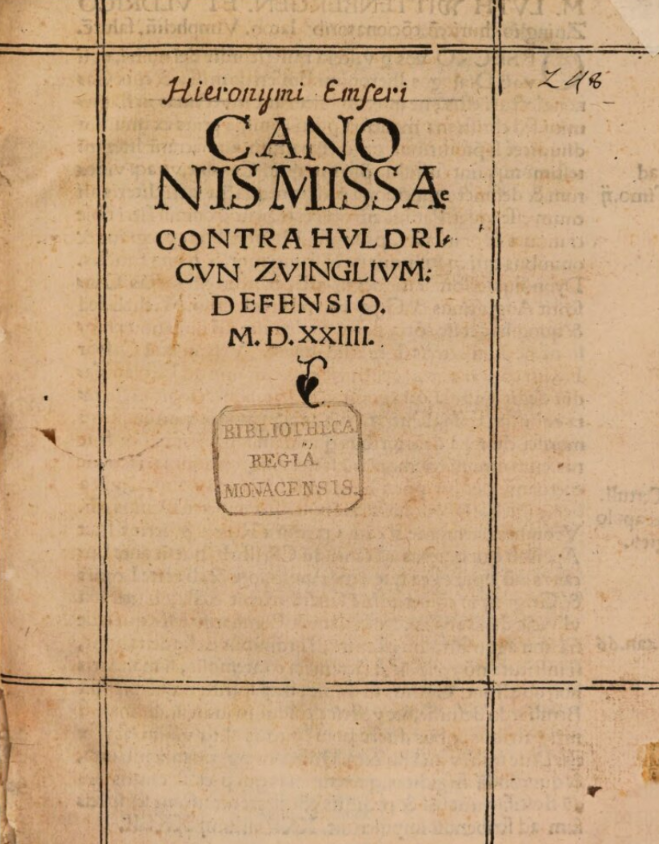
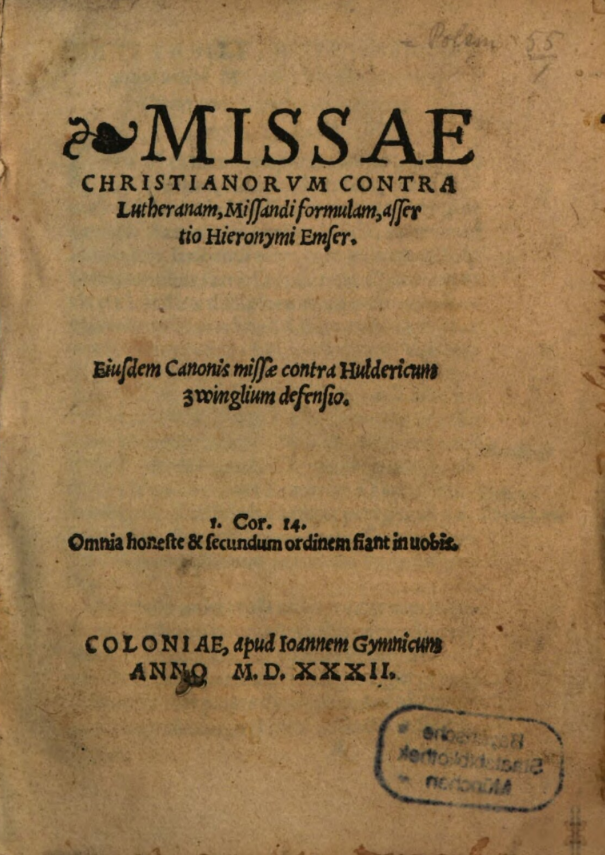
A comparison of the publications suggests that the copyist followed, maybe surprisingly, the first, the Dresden edition. Several cases of conflicting readings between the editions can be noted, but our manuscript renders almost exclusively the Dresden one, which, by the way, proves to be the most accurate of the three.
However, following the most accurate imprint does not mean it itself is highly accurate; rather, it is riddled with mistakes and countless deviations, as was said. Part of these are common transcription errors, such as the slipping of lines, duplication of words, switching of similar looking letters, verb moods or tenses and – though it might have been done on purpose – omissions of words, sometimes even of several lines, which were, occasionally and where space would permit it, corrected. The case endings of words were (deliberately or not) harmonised several times throughout the text, apparently trying to adjust to case endings of previous words in an attempt to correct an alleged mistake, thus not just confusing antecedents but rendering the grammar of several sentences wrong. The scribe did and did not, as it were: follow the text. After all, it seemed just about securing it.
What seems characteristic for the copyist is his changing the order of words (e. g. Cristo quidem instead of quidem Christo; etiam ipse instead of ipse etiam; or praecamur deum instead of deum praecamur), also his constant swapping of pronouns (id instead of illud; istud instead of illud; istorum instead of eorum etc.). Again and again words are replaced by similar ones as in universum mundum instead of totum mundum or non est instead of nulla est. Also, conjunctions are switched such as et, atque and at (at instead of et; et instead of atque etc.). Considering the abundance of errors and deviations, it seems the copyist occasionally lost his focus during the process of transcribing, and that he might have taken some liberties in changing things, though the careful appearance of the manuscript and the revision he undertook may suggest otherwise. The biggest blunder, however, is found right at the beginning, as he copies the wrong dedication, mixing it up with the dedication of the preceding text, Emser’s tract against Luther!
As an example, pars pro toto, of how copy mistakes change the meaning of the printed original, but in a way that it doesn’t make sense, so that there could hardly be found some latent intention of the scribe behind it, may serve the following:
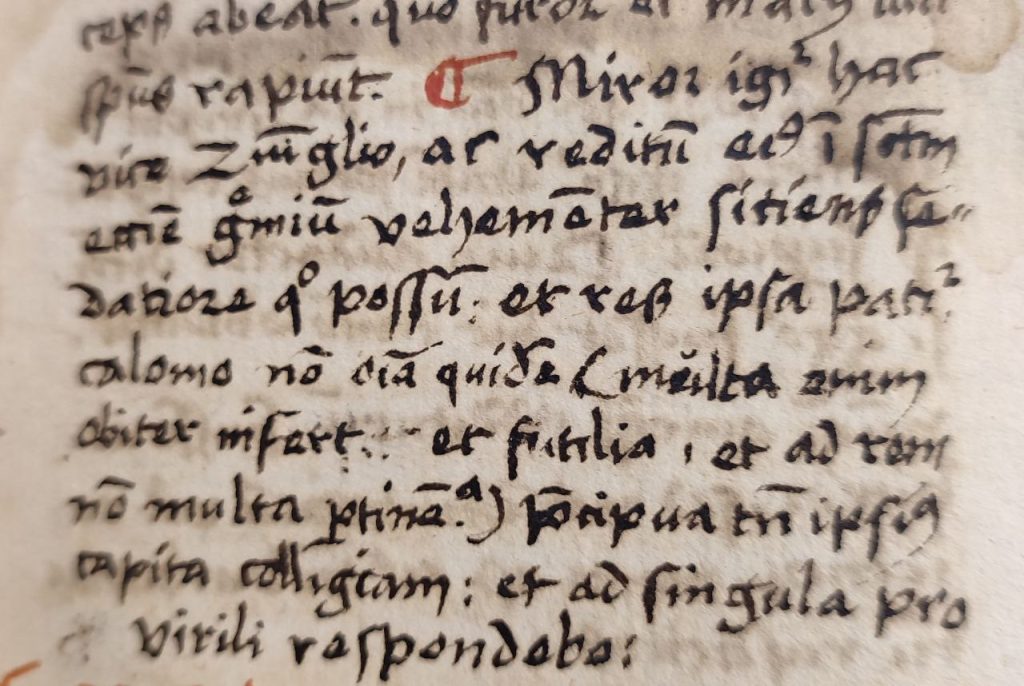
Dresden imprint (sig. Aiijr): Mitior igitur prima hac vice Zvinglio ac reditum eius in sanctum ecclesiae gremium vehementer sitiens, sedatiore quo possum et res ipsa patitur calamo, non omnia quidem (multa enim obiter infersit, et futilia et ad rem non multum pertinentia) precipua tamen ipsius capita colligam, et ad singula pro virili respondebo.
„So on this occasion of my first response, as I am more patient with Zwingli and indeed eagerly longing for him to return to the holy bosom of the church, employing a calmer pen [i.e. than in the case of Luther] as much as I can and as the very matter allows it, I will, to be sure, address his main arguments and answer each of them to the best of my ability; not everything of course (as much of it he has just squeezed in by coincidence, futile content and hardly things that matter regarding our subject).“
Manuscript (fol. 2r): Miror igitur prima hac vice Zvinglio, ac reditum eius in sanctum ecclesiae gremium vehementer sitiens sedatiore quo possum, et res ipsa patitur, calamo non omnia quidem (multa enim obiter infert, et futilia, et ad rem non multa pertinentia) precipua tamen ipsius capita colligiam*, et ad singula pro virili respondebo.
„So caught by surprise because of this occasion of my first exchange (of arguments) with Zwingli, and indeed eagerly longing for him to return to the holy bosom of the church, employing a calmer pen [i.e. than in the case of Luther] as much as I can and as the very matter allows it, I will, to be sure, address his main arguments and answer each of them to the best of my ability; not everything of course (as much of it he has added by coincidence, futile content and not many things that matter regarding our subject).“
* The printed version reads correctly colligam instead of the flawed colligiam in the manuscript.
Comparing the two versions (mitior vs. miror) shows that the latter doesn’t make much sense, aside from the fact that its translation is only one way of trying to render it (sort of) meaningful. The scribe has simply muddled up (or misread) the vocabulary rather than making corrective interventions as a textual critic.
A lovely, ‘creative’ and probably even intentional example may, however, furnish the following passage:

Dresden imprint (sig. Aiijr): Dominus enim, qui me hactenus eripuit de ore leonis et ursi, hoc est Carolostadii et Luteri […], ipse me liberabit de manu Philistei huius, quoniam quis est iste incircumcisus tam corpore quam corde et labiis, qui ausus est maledicere exercitui Dei viventis?
„For indeed, the Lord Himself, who has thus far rescued me from the jaws of the lion and the bear, in other words Carolostadius and Luther […], will deliver me from the hand of this Philistine, for who is this uncircumcised person, in body, heart and words, who has dared to offend the army of the living God?“
Manuscript (fol. 1v): Dominus enim, qui hactenus me eripuit de ore leonis et ursi, hoc est Carolostadii et Luteri […], ipse me liberabit de manu Philistei huius, quoniam quis est iste incircumtonsus tam corpore quam corde et labiis, qui ausus est maledicere exercitui Dei viventis?
„For indeed, the Lord Himself, who has thus far rescued me from the jaws of the lion and the bear, in other words Carolostadius and Luther […], will deliver me from the hand of this Philistine, for who is he who has thrown away his tonsure, in body, heart and words, who has dared to offend the army of the living God?“
The Dresden printing reads incircumcisus („uncircumcised“) and together with the Philistine part clearly refers to 1. Sam: 17, 26 (quis est enim hic Philistheus incircumcisus qui exprobravit acies Dei viventis – „For who is this uncircumcised Philistine, that he should defy the armies of the living God?“). The manuscript reads incircumtonsus („untonsured“, giving up one’s tonsure), which might be a reading mistake of the copyist, however could also be an intended disambiguation, in order to point at Luther and his like who usually had been monks having turned away from their religious vows.
Regarding the manuscript’s time of origin, there is a strong argument for a terminus post quem, which is the year 1526, to be more precise August of 1526, in other words two years after the Dresden and Strasbourg editions of Emser’s tract had been released. Strikingly, in the manuscript, Emser’s text is preceded by the previously quoted introduction, written by the same hand, which refers to Jodocus Clithopheus’ Propugnaculum Ecclesiae adversus Lutheranos, published in Paris only in August 1526. Jodocus, better known as Josse van Clichtove (1472/73–1543), was a Flemish theologian and fierce antagonist of Luther. The added introduction quotes almost verbatim a passage from chapter 6 of book 1 of Jodocus’ Propugnaculum, a rough summary and praise of Emser’s two writings against Luther and Zwingli, „the Lutherans’ wicked soldier“ (Luterane factionis improbum militem). What is thus yielded is a somewhat reliable terminus post quem, as it is rather unlikely – though not impossible – that Jodocus himself was the one copying Emser’s response. He, of course, would have known about his own (not yet published) work.
Needless to say, the question must be asked: Who copied the text, or commissioned it, and why? Could he (or was it a she?) not purchase a copy, or was it hard to get one? Was he or she in a rush – which might explain the numerous oversights, not however the careful presentation – and when and under what circumstances was it copied? What should also be asked is the provenance of the manuscript and, accordingly: Whose library did it belong to?
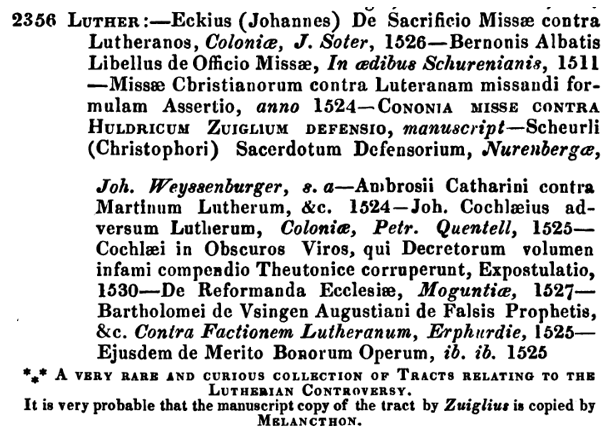
Sotheby’s „Catalogue of the Library of Dr. Kloss“, which lists all the books it acquired from the German book collector, seems to provide an answer: the German Reformer Philipp Melanchthon! It indeed lists the collective volume of Reformation polemics, which the Bodleian appropriated by auction for ₤190, as „a very rare and curious collection of tracts relating to the Lutherian controversy“, saying that „it is very probable that the manuscript copy of the tract by Zvinglius [one of the many mistakes of the catalogue: the text is Emser’s against Zwingli] is copied by Melanc[h]thon.“ However, one should not get too excited about it because it is, as we say today, fake news. Sotheby’s seems to have employed a clever marketing strategy, accordingly claiming, or rather advertising, a huge bulk of the Kloss-collection as Melanchthon’s – not without annoying Kloss. Over the years, the very person would write several letters betraying his indignation, and in 1841 finally release a public statement in which he distanced himself from Sotheby & Son’s „fabricating a Bibliotheca Melanchthonia.“ The poor fellow (i.e. Melanchthon), so Kloss, would still be suffering from aching hands had he indeed written all the marginalia as stated in the Catalogue. Kloss seems to have grown concerned that Sotheby’s shenanigans might taint his own name. Moreover, it was a question of honour for him not to be silent on the swindle and to distance himself from their „Melanchthomania“, even expressing his urge to protest in Melanchthon’s name.
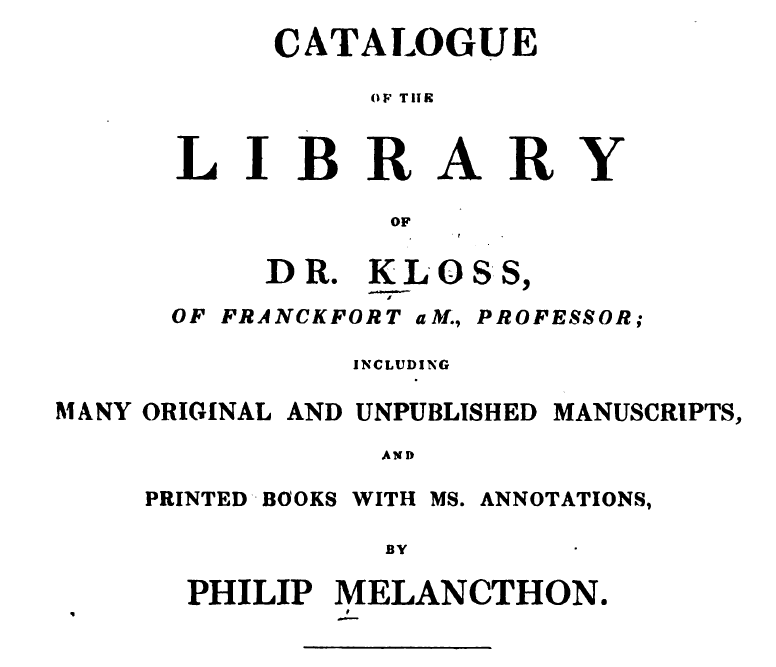

That the manuscript did not come from Melanchthon’s library is hardly surprising, taking into account its highly pro-Catholic content and the anti-Lutheran attitude of the whole collective volume, let alone the fact that the handwriting does not match Melanchthon’s. Sadly, Kloss‘ records on all the works sold to Sotheby’s, with their accompanying notes and information, have been lost. Kloss had criticised Sotheby’s for not using his catalogue, for not making the effort to translate it into English, and instead publishing their own flawed one brimming with errors and misinformation. When he tried to reclaim his catalogue, it was to no avail. As it was lost, valuable information about our manuscript might have been lost with it.
What remains is what Kloss mentions, for instance several libraries from which the majority of his books sold to Sotheby’s came, including the libraries of the bishop Johann von Dalberg (1455–1503), Bernhardt Adelmann von Adelmannsfelden (1459–1523), Christian Scheurl (1601–1677), Johann Fichard (1512–1581) and the abbeys of Esslingen and Ochsenhausen. The former two were not alive at the time of the manuscript’s composition. Johann Fichard was probably too young even though it might have been his father’s, Johann Fichard’s sen. (1470–1530), copy, who was rector at the Liebfrauenstift school in Frankfurt. Christian Scheurl was the descendant of Christoph (II.) Scheurl (1481–1542), well known for his mediating efforts during the Reformation. A work of his (Libellus de Sacerdotum ac rerum ecclesiasticarum Praestantia, Nuremberg 1512) forms part of the collective volume, situated immediately behind our manuscript. However, in this case, his handwriting does not seem to fit either. As far as the libraries of the abbeys are concerned, the one of Esslingen should be ruled out as it sold all its ‘popish’ writings in the 17th century. The library of Ochsenhausen on the other hand was relocated to Bohemia by Clemens Wenzel von Metternich in 1825, and more information is not available.
So, who was the copyist or its commissioner? Where did the volume originate, and whose library did it belong to? It is possible, though unlikely, that it came from Jodocus Clichtoveus’ library, the one quoted in the manuscript’s summary introduction (in this case, he had ‘quoted’ himself), known for exploring arguments against Luther in preparation for the Synod of Paris in 1528. The fact of self-quotation may contradict this assumption. What is likely, generally speaking, is that the volume originated from the library of a well-educated Roman Catholic with a keen interest in the topic, collecting texts dating back to the 11th century, such as Berno von Reichenau’s Libellus de Officio Missae, as well as contemporary 16th-century tracts. Unfortunately, more cannot be said about these certainly pertinent questions, although further research might provide clarification.
Despite containing a well-known text, our manuscript remains rather mysterious, raising more questions than giving answers. While it very likely does not share the 500th birthday with Emser’s Canonis Missae contra Huldricum Zvinglium Defensio, as we have suggested, its unearthing can certainly and worthily stand in place as a celebration of Emser’s tract from 1524. Moreover, it may invite and inspire further scholarship not only on the topic but also on itself. And, last but not least, it serves as a true reminder that there may still be undiscovered treasures within the vast universe of libraries, even within renowned institutions like the Bodleian. At any rate, Colin Harris’ finding is a remarkable one.

References:
- Theobald Freudenberger, Hieronymus Emser. Schriften zur Verteidigung der Messe (Münster 1959).
- Georg Kloss, ‚Ueber Melanchthons angebliche Handschriften, welche in dem Catalogue of the Library of Dr. Kloss verzeichnet sind‘, Serapeum 24 (1841), pp. 369–377.
